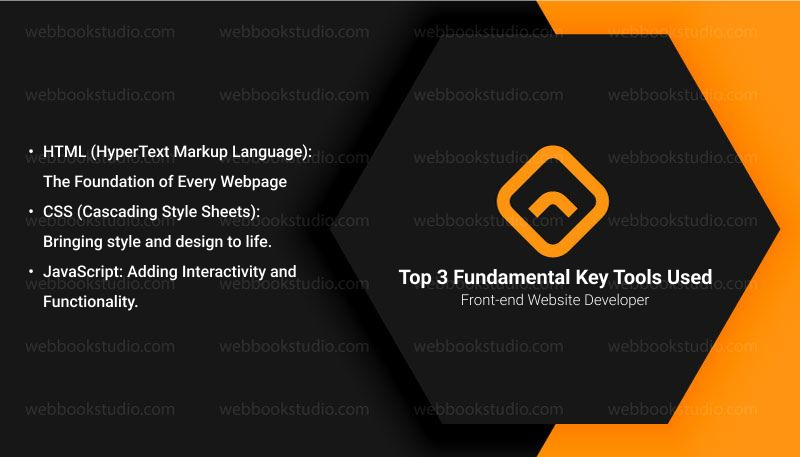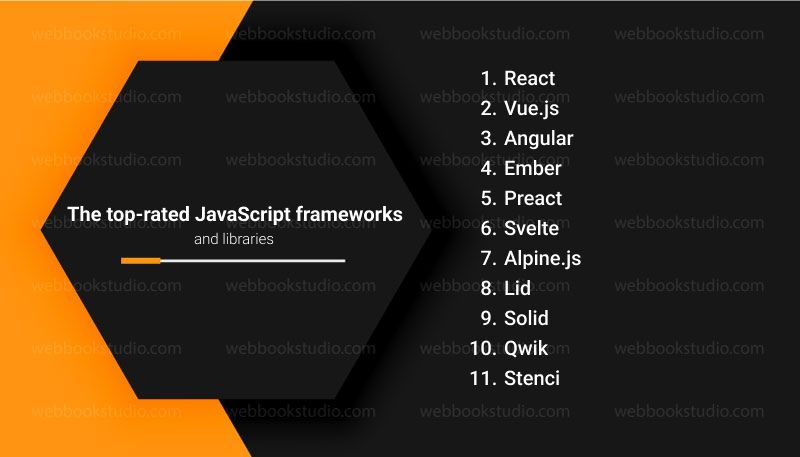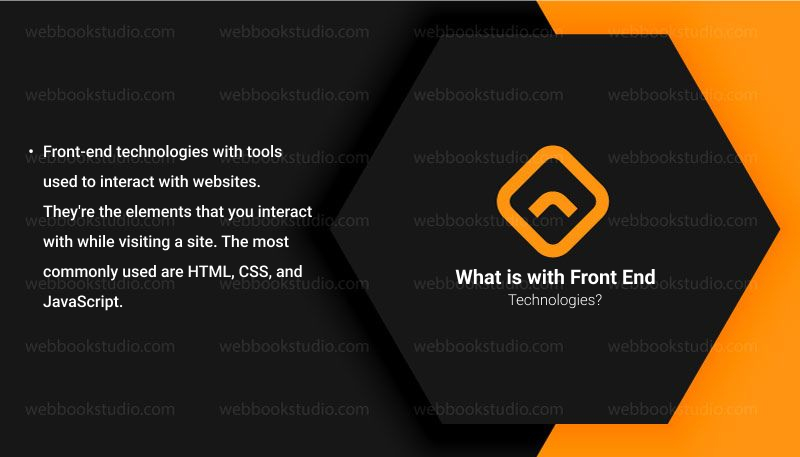Discover the Secret World Technology of Front-end Website Development Tools.
Front-end Website; Are you Ready to Dive into the Exciting World of Evolution Technologies? If so, get ready to embark on a hidden journey filled with creativity and innovation! FEWD (Front-end Website development) has become an integral part of the digital landscape, as businesses strive to create visually incredible and user-friendly websites that captivate their target audience. However, achieving such results would not be possible without the deployment of key tools and technologies specifically designed for front-end development. These tools empower developers to craft seamless user experiences by leveraging cutting-edge techniques and functionalities.
In this article, Webbook Studio expertise Web and mobile developers will explore some of the key tools and technologies that are essential for every FEWD platform. From HTML and CSS to JavaScript frameworks and responsive design, these magical tools will empower you to create amazing online sites that captivate your audience. So grab your coding superhero point and let’s uncover the secrets behind front-end website development!
Get an Exclusive Overview of Front-end Website Technology with Development
Front-end Website Technologies are Mythology! The tech sector is constantly full of activity due to the excitement brought by the vast advantages that front-end developers can get. Keeping pace with the latest technological advancements in this area is becoming challenging. The design and creation of websites was an idea that was entirely out of the box. The fact that made possible by allowing development to complete in just two hours is why it’s a trend. Tools for front-end design and development and technology are the initial step in Full Stack Web development, which covers the action-based and visual interface that governs the interaction segment.
FEWD no wonder it’s expanding to the point that you can expect to find an updated library every few months. With the variety of tools available, picking the most suitable one can be difficult. However, do not be upset. We have searched the web and made the top front-end development tools with the most advanced features. So, let’s look and the details of the distinct elements that make up the significance of top front-end tools for online development.
Helpful Article; Web app development company: which is the best?
Top 3 Fundamental Key Tools Used Front-end Website Developer

1. HTML (HyperText Markup Language): The Foundation of Every Webpage.
HTML is a markup language utilized to build websites and web-based applications. The main purpose of using HTML5 allows you to create a web-based document that will be displayed on multiple browsers without problems. HTML5 is regarded as the most popular front-end template or one of the most popular front-end technologies.
2. CSS (Cascading Style Sheets): Bringing style and design to life.
That can be used to design your HTML website to make it appear attractive by incorporating fonts, colors, and more. CSS can improve the look of your site’s design.
3. JavaScript: Adding Interactivity and Functionality.
Frameworks with JavaScript: Simplifying and streamlining the development process, lets you include interactivity on your site by incorporating events such as clicks and clicks. To ensure that a variety of tasks can be accomplished easily. It is a well-known front-end technology development.
What are Front-end Website Test Examples?
FEWD frameworks: Streamlining development with pre-built components. Front End Testing validates that the GUI elements work according to the specifications. For instance, it examines whether input fields can accept the proper characters when forms are submitted after all required fields have been completed, whether the navigation is straightforward enough when the page loads quickly enough or loading quickly enough, Etc.
Frameworks with Libraries that FEWD is Top Popular Used Developers.
In the Front-end Website innovation process, picking the right framework for creating a responsive, fast, safe User Interface (UI) is normal. What are the current trends concerning the use and popularity of these frameworks? We will examine the survey results and analyze the most recent data on framework usage and popularity gathered from the State of Javascript. Based on the study, the top-rated JavaScript frameworks and libraries that have been in use for a long time are ranked according to the:

Get more information: The advantages of Outsourcing Web application development for Enterprises
15 Top Exclusive Tools Consider for Front-end Web Development in the Future.
Front-end Website frameworks and trends evolve quicker than used. Therefore, Best 15 Tools get here is an up-to-date, organized checklist to keep track of the Elegance front-end development tools for the Future.
1. Atom; Exclusive Front-end Website Frameworks.
Atom is a program developed by GitHub Atom, a GitHub-owned company, is a no-cost open-source and community-built desktop software that can use as a text editor and source code editor. It uses Less, CoffeeScript, JavaScript, and HTML programming languages. Atom can use for Linus, macOS, and Microsoft Windows. Built on the Electron framework that supports desktop applications that run on multiple platforms, Atom is extraordinarily flexible and customizable by integrating Git Control along with multi-cursor plugins created in JavaScript. The appearance and mapping of key combinations are easy to do with Atom. Outstanding syntax highlighting capabilities, along with various interactive functions, is an added feature. Its modular and flexible design makes it easy for users to use and easy to use.
2. JQuery is the First to Choose FEWD Development Tools.
Licensed under MIT and jQuery, the JavaScript library was developed to make it easier for HTML Tree traversal and manipulation. It also is utilized to handle events, Ajax, and CSS animation. jQuery is used by 48.7% of developers, which makes it among the top-used toolkits for the front-end development of web applications. The library is at least 3-4 times more used than any similar product because of its ease of use, incredible animations, and the development of abstractions to support low-level interactions. That is helpful with Reusable, readable, less and more clear code with the API’s documentation and cross-browser compatibility, and its minimalistic design makes jQuery user-friendly.
3. Git Best Control of Versions Software.
Git is the most widely used software for distributed control of versions that are used to track changes. It is written using Shell, C, Perl, and Tcl and is free of cost. The fundamental premise behind its design is simplicity and speed, with the complete distribution of non-linear workflows and integrity, as well as the ability to support multiple branches in parallel. Git can manage small files and large projects and offer the best support and effectiveness. That comes with a simple guide to understanding the fundamentals like;
- Creating a repository, tracking changes, branch management, and merging changes through pull requests.
- Git has earned a top ranking in terms of performance in terms of optimizing merging, branching, and committing.
- Git also has cryptographic security.
So, that programmers can benefit from smooth contextual switching and role-based programming and an opportunity to test Git regularly.
Supported Article; Web & mobile app developer: how to find?
4. Flutter; Smartphone support Front-end Website developer Choose Tools
That is a mobile cross-platform application development framework developed by Google to create top-quality native apps designed for iOS and Android with a single codebase. It’s among the most well-known front-end technologies.
5. Angular.js
Angular.js is an open-source, extensible JavaScript front-end development tool and a web framework. Its primary goal is the ease of development and testing of software. It provides client-side model-view-controller (MVC) and model-view-view-model (MVVM) architecture. The basic HTML framework and DOM technique make the website extremely responsive and dynamic. Two-way data binding and dependency injections, as well as various directives, templates, and testing tools, are some of the features of Angular.js. The codes encourage reuse, and the benefits include improved plugin controls. It also promotes the development of apps faster. It gives advanced capabilities to create simple and easy-to-manage single-page applications.
Get more details; What is website development and why it is important?
6. Headless CMS.
The Headless CMS (Content Management System) is a platform for websites that allows you to manage content without worrying about the back end of your site. It is among the most well-known front-end developers. The headless system for managing content (CMS) is a back-end feature that permits content creators to organize and store their content; however, it does not provide an interface layer for front-end use. Content is instead delivered via APIs and can be displayed on various front-end applications such as smartphones, mobile apps, and so on. That is gaining popularity, and many companies are already promoting headless CMS capabilities for their platforms. A few of the most popular headless CMS to look into for the future include;
- Sanity
- Storyblok
- Contentful
- Starpi
- Hygraph, and many more.
Supported Article: What are the ways to design and develop a mobile app?
7. HTML5 Boilerplate
Auxiliary start of Journey with HTML5 Boilerplate is a Combo pack like; HTML5, CSS, HTML, and JavaScript-based templates used to create websites that are cross-browser compatible. It includes HTML5-compatible elements as well as features that assist in creating a complete and robust website. Instead of creating a new page each moment, utilize HTML5 Boilerplate for fast and easy-to-use templates. It aids in maintaining the accessibility and reliability of documentation. It also has a code structure with a high abstraction level and an ideal coding standard that is easy to learn. CLI tools aid in improved design and setup of the site. Additionally, it hosts many tools, such as API features and tools for testing.
8. Vue J.S. Exclusive (MVVM) Architecture Framework.
Vue.js is a progressive open-source framework that follows Model-View-View-Model large companies Vue J.S. frameworks utilize another JavaScript library to create interactive Web interfaces to build their front-end technology. It is utilized to create user interfaces and SPAs (Single Page Applications) and further extend basic HTML codes to make reused codes. It is a reactivity system that makes use of Javascript elements as well as re-rendering optimization.
Relevant informative Article; What is a custom web design and web development?
9. Bootstrap: Best Open Source Design Software.
Bootstrap is an open-source CSS framework that is entirely free to use. It aims to develop mobile-friendly, responsive, and easy front-end web development. It includes design templates for interface elements like buttons, forms, typography, and navigation. It’s a powerful web and mobile app front-end development tool to ensure greater efficiency. Its main feature is the streamlined development process for informative websites. JQuery plugins within Bootstrap constitute a crucial element in the Bootstrap framework.
10. Ionic; Basic Mobile app Tools for FEWD.
Ionic can be described as a front-end tech that allows mobile apps to be built using HTML, CSS, & JavaScript. It will enable you to use existing tools, such as Angular and React, without learning new frameworks or languages. Expertise Developers apply front-end technology like Angular, React, or Vue.js with Ionic software as the primary tools for designing user interfaces.
Best Supported Article: Cross-Platform Mobile App Development: Ionic Framework
11. CodePen; Social Networks Software Front-end Website use
The CodePen program is a development environment for social networks that allows you to create and design front-end web pages. It will enable you to write precise code and syntax. It is a valuable, versatile, flexible, and accessible code editor. You can not only create your website, but you can also discover artistic and imaginative designs within the program.
12. SAAS Program with Front-end Website Innovation support.
CodePen offers web-based SAAS (Systematically Awesome Stylesheets) options for programmers. It’s a user-friendly tool that provides an interactive and educational setting to help you create user-friendly work. Sass is employed to bring more style and ease to simple CSS languages. It is a pre-processor whose use extends beyond nested rules and syntax, mixins, inline imports, and variables. Additionally, it can support small, compact, and well-organized stylesheets. However, Superset CSS is constructed upon the JavaScript programming language, and coded in Ruby. It permits fewer codes and uses less CSS in the programming language. Developers favor this robust, safe, stable, and secure Sass framework. Maths and color manipulation are further incorporated into the nesting functions. In general, Sass generates customizable and adequately formatted output.
13. Sublime Text
Basically, Sublime Text is a cross-platform-based source code editor with numerous markups and remarkable programming languages. Python API facilitates plugins. Adaptive match-ups allow rapid keyboard input in the case of undefined commands. That makes it simple to use and ensures that orders create error-free. CodePen is also a tool that offers many possibilities for customization with the help of JSON setting files. It’s compatible with Windows, macOS, and Linux and works with various languages. The custom preferences of each project and the simultaneous editing make it a fantastic Front-end Website Development Tool. Explore the best projects designed for novices that you can create. The lightweight, stable, and quick framework that can handle everything from syntax highlighting to auto-completion and code folding is one of the most popular options for programmers.
14. NPM; Front-end Website Developers Management Tools.
NPM is a cross-platform application manager run-time environment designed for JavaScript language. It is connected to the remote registry using the command-line interface. It can manage locally and globally installed and well-established JavaScript tools. The main uses include;
- Finding
- Installing
- Creating
- Publishing node-based programs.
It is a full-stack development tool that works with client and server-side applications. NPM runs on a single-threaded event-driven loop. It offers event-driven APIs that aid in executing non-blocking tasks. It is a simple and highly scalable FEWD tool that can support huge and top-active communities.
Exclusive blog; Mobile Application Development. How to start?
15. TypeScript; Smooth Front-end Website team Performance Tools
It was developed in collaboration with Microsoft; TypeScript is a hyper-syntactical and hardcore version of JavaScript that offers an added later version of static typing. It is an open-source full-stack development tool to generate large dynamically typed files. TypeScript assists in ensuring proper rigid and structural typing and convenient annotations. It is an excellent tool for managing self-documenting codes, which work with other libraries. That is second in well-known programming language and promises better team performance. Furthermore, it offers speedy development and easier debugging since it identifies errors in the compilation.
Front-end Website Developers Creative An Ever-Evolving Toolbox
The range of web-based FEWD tools could result in much confusion. Selecting the best tool can be difficult with constant and frequent updates or trends that evolve as the sun sets. An easy and effective framework need to create exceptional web pages or apps. With the list, as mentioned earlier, of recommended features, developers can take advantage of the benefits of a variety of capabilities on a single platform. But, a Front-end web development certification is required to sharpen your abilities and know the art of custom building websites.
Informative Article; Top 5 PHP web development companies in the USA?
Conclusion about Front-end Website Importance of using the right tools.
Front-end Website development relies heavily on a variety of key tools and technologies. From foundation structuring and styling content with JavaScript for adding interactivity and functionality. These languages form the foundation of any front-end project. Additionally, frameworks such as Bootstrap and libraries like jQuery help streamline the development process by providing pre-built components and code snippets. Version control systems like Git enable collaboration among team members and ensure the integrity of the codebase. Web developers can create stunning user experiences that meet modern standards. Get in Touch with Us and don’t hesitate to explore these resources further and enhance your FEWD skills today.
FAQ: FEWD Technology Used.
1. What is with Front End Technologies?

Front-end technologies with tools used to interact with websites. They’re the elements you view that you interact with while visiting a site. The most commonly used are HTML, CSS, and JavaScript.
2. What framework would be ideal in front-end design?
Frameworks allow you to make front-end technologies simpler and more productive. They’re collections of HTML, CSS, and JavaScript code used to build your website. AngularJS, ReactJS, and VueJS are among the top frameworks.
3. Which tools does front-end development employ?
Front-end developers make use of;
- Web browsers include Chrome or Firefox.
- Text editors, like Sublime Text and Atom, for writing codes.
- Version managers for code like Git can aid developers in tracking modifications made to code.
4. What is the most efficient Front-end Language?
There are numerous front-end programming languages, each with strengths and weaknesses. If you’re beginning, HTML and CSS are easy to master. JavaScript allows you to create interactive pages. If you’re seeking something more sophisticated (and less common), consider C++ or Java.
5. Which is the fastest front-end development framework?
There are a variety of frameworks available that can use for front-end development. However, it’s all dependent on the goals you’re attempting to achieve. The two most well-known platforms are Vue.js and React.js, with their flexibility and suitability for virtually any project.

